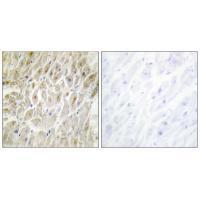

| WB | 咨询技术 | Human,Mouse,Rat |
| IF | 咨询技术 | Human,Mouse,Rat |
| IHC | 1/50-1/100 | Human,Mouse,Rat |
| ICC | 技术咨询 | Human,Mouse,Rat |
| FCM | 咨询技术 | Human,Mouse,Rat |
| Elisa | 咨询技术 | Human,Mouse,Rat |
| Aliases | Homeobox protein DLX-3; DLX3; |
| Entrez GeneID | 1747; |
| WB Predicted band size | 45kDa |
| Host/Isotype | Rabbit IgG |
| Antibody Type | Primary antibody |
| Storage | Store at 4°C short term. Aliquot and store at -20°C long term. Avoid freeze/thaw cycles. |
| Species Reactivity | Human,Mouse |
| Immunogen | Synthesized peptide derived from internal of human DLX3. |
| Formulation | Purified antibody in PBS with 0.05% sodium azide. |
+ +
以下是关于DLX3抗体的3篇参考文献的简要概括(注:内容基于公开研究归纳,具体细节建议通过学术数据库核实):
---
1. **文献名称**:*DLX3 regulates osteoblast differentiation by controlling bone morphogenetic protein (BMP) signaling*
**作者**:Nakamura, T., et al.
**摘要**:该研究利用DLX3抗体通过免疫组化和Western blot技术,揭示了DLX3转录因子在成骨细胞分化中的关键作用,发现其通过调控BMP信号通路影响骨形成。
2. **文献名称**:*Mutations in DLX3 impair ameloblast differentiation and lead to hypoplastic dental enamel*
**作者**:Hassan, M.Q., et al.
**摘要**:通过免疫荧光染色结合DLX3抗体,研究者发现DLX3基因突变会干扰成釉细胞分化,导致牙釉质发育不全,表明DLX3在牙釉质形成中的必要性。
3. **文献名称**:*DLX3 modulates epidermal to hair follicle stem cell transition via Wnt signaling*
**作者**:Morasso, M.I., et al.
**摘要**:该研究使用DLX3抗体在小鼠模型中定位蛋白表达,证实DLX3通过调控Wnt通路促进表皮干细胞向毛囊干细胞转化,影响皮肤及毛发发育。
---
**提示**:若需获取全文或具体实验方法,可通过PubMed或Google Scholar检索标题及作者,结合关键词“DLX3 antibody” “immunostaining”等进一步筛选。
The DLX3 antibody is a tool used to detect and study the DLX3 protein, a member of the Distal-less (DLX) family of homeodomain transcription factors. DLX3 plays critical roles in regulating gene expression during embryonic development, particularly in tissues derived from the ectoderm and mesoderm. It is essential for the development of teeth, hair, bones, and epithelial structures, and it influences cell differentiation, apoptosis, and extracellular matrix formation. Mutations in the DLX3 gene are linked to human genetic disorders such as Tricho-Dento-Osseous syndrome (TDO), characterized by defects in hair, teeth, and bone.
DLX3 antibodies are widely used in research to investigate its expression patterns, molecular interactions, and regulatory mechanisms. They enable techniques like immunohistochemistry, Western blotting, and immunofluorescence to localize DLX3 in tissues or quantify its levels in cellular models. Studies leveraging DLX3 antibodies have expanded understanding of its role in developmental pathways, craniofacial morphogenesis, and diseases like cancer, where dysregulated DLX3 expression may contribute to tumor progression.
Commercial DLX3 antibodies are typically raised against specific epitopes of the human or murine DLX3 protein, with validations confirming specificity. Their applications span developmental biology, oncology, and dental research, providing insights into DLX3’s dual roles as a transcriptional activator and repressor in health and disease.
×